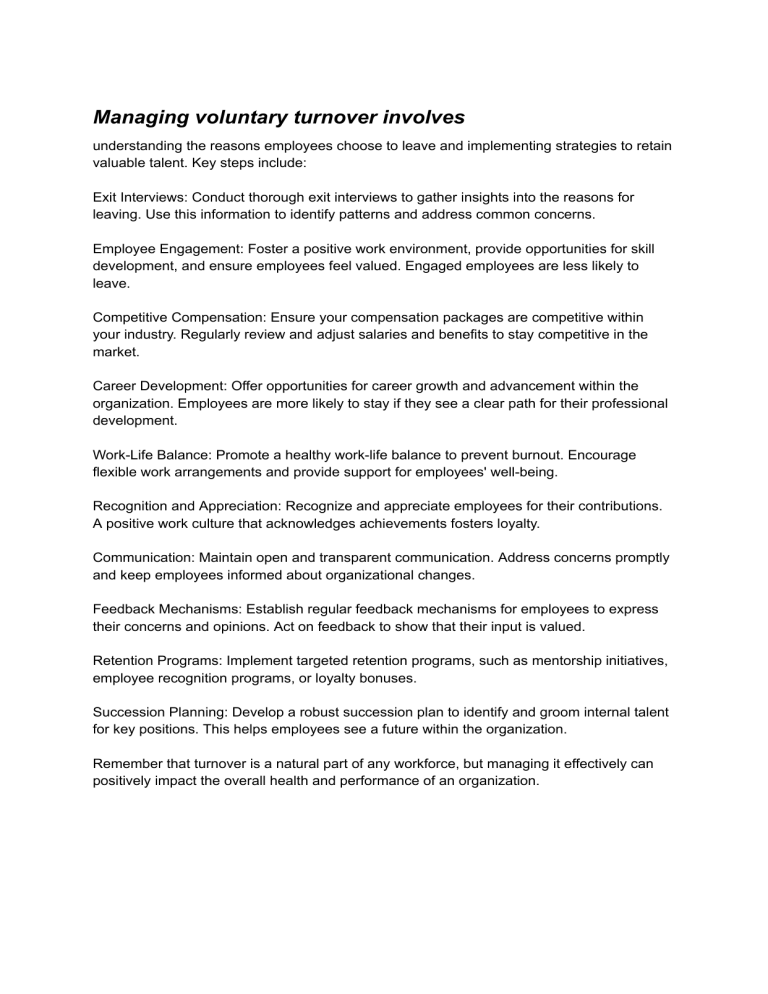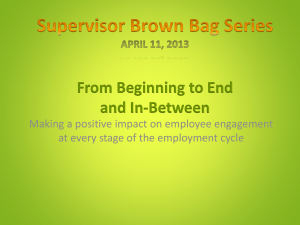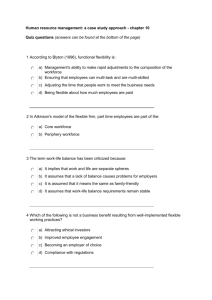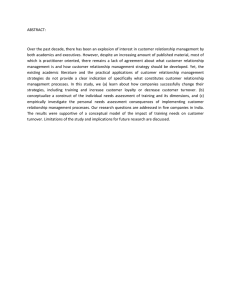
Managing voluntary turnover involves understanding the reasons employees choose to leave and implementing strategies to retain valuable talent. Key steps include: Exit Interviews: Conduct thorough exit interviews to gather insights into the reasons for leaving. Use this information to identify patterns and address common concerns. Employee Engagement: Foster a positive work environment, provide opportunities for skill development, and ensure employees feel valued. Engaged employees are less likely to leave. Competitive Compensation: Ensure your compensation packages are competitive within your industry. Regularly review and adjust salaries and benefits to stay competitive in the market. Career Development: Offer opportunities for career growth and advancement within the organization. Employees are more likely to stay if they see a clear path for their professional development. Work-Life Balance: Promote a healthy work-life balance to prevent burnout. Encourage flexible work arrangements and provide support for employees' well-being. Recognition and Appreciation: Recognize and appreciate employees for their contributions. A positive work culture that acknowledges achievements fosters loyalty. Communication: Maintain open and transparent communication. Address concerns promptly and keep employees informed about organizational changes. Feedback Mechanisms: Establish regular feedback mechanisms for employees to express their concerns and opinions. Act on feedback to show that their input is valued. Retention Programs: Implement targeted retention programs, such as mentorship initiatives, employee recognition programs, or loyalty bonuses. Succession Planning: Develop a robust succession plan to identify and groom internal talent for key positions. This helps employees see a future within the organization. Remember that turnover is a natural part of any workforce, but managing it effectively can positively impact the overall health and performance of an organization. Managing involuntary turnover which involves termination or separation initiated by the employer, requires sensitivity, adherence to legal requirements, and strategic planning. Here are key considerations: 1. **Legal Compliance:** Ensure that all terminations comply with local labor laws and regulations. Seek legal advice to minimize the risk of legal repercussions. 2. **Clear Policies and Procedures:** Have well-defined and documented policies for terminations. Ensure employees are aware of performance expectations and consequences. 3. **Communication:** Handle terminations with empathy and respect. Clearly communicate the reasons behind the decision, maintaining confidentiality when necessary. Provide necessary support during the transition. 4. **Outplacement Services:** Offer outplacement services to help departing employees with career transition. This could include resume writing, job search assistance, and interview coaching. 5. **Documentation:** Maintain thorough documentation of the reasons for termination, performance issues, and any warnings given. This documentation can be crucial if legal issues arise. 6. **Feedback and Learning:** Use involuntary turnover as an opportunity for organizational learning. Conduct exit interviews to understand any underlying issues and improve processes. 7. **Support for Remaining Employees:** Address any concerns or uncertainties among the remaining workforce. Clearly communicate changes and provide reassurance about the organization's commitment to its employees. 8. **Reassess Workforce Planning:** Consider the impact of the departure on the team and the organization. Reevaluate workforce planning, redistribute responsibilities, and plan for any necessary recruitment or internal promotions. 9. **Training and Development:** Assess if additional training and development programs are needed to address performance issues within the organization and prevent similar situations in the future. 10. **Maintain Morale:** Actively work to maintain morale among remaining employees. Recognize their contributions, address concerns, and emphasize the organization's commitment to its workforce. Involuntary turnover is challenging, but handling it professionally and ethically can contribute to the overall health and resilience of the organization.




